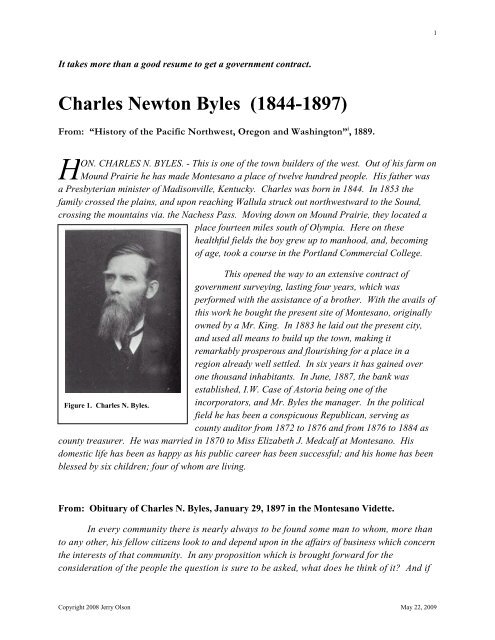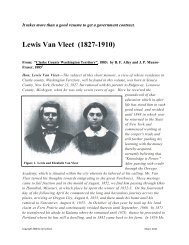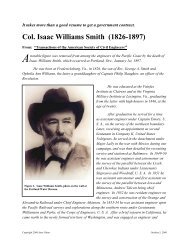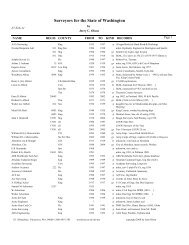Charles Newton Byles (1844-1897)
Charles Newton Byles (1844-1897)
Charles Newton Byles (1844-1897)
- No tags were found...
You also want an ePaper? Increase the reach of your titles
YUMPU automatically turns print PDFs into web optimized ePapers that Google loves.
5farm on week days and on Sundays preached. He would go for miles on foot or horsebackbut always preached every Sunday. He was a Cumberland Presbyterian minister. He wasalso a charter member of the A.F. & A.M. Grand Mound Lodge Number 3, having joined inthe Madison Lodge in Madisonville, Kentucky in 1840. He died February 26, 1869 at hishome on Grand Mound Prairie, leaving his wife, two sons, David F. <strong>Byles</strong> and my father,<strong>Charles</strong> N. <strong>Byles</strong>; two daughters, Mrs. M. Z. Goodell of Montesano and Mrs. D. B. Ward ofSeattle. All are now dead.Grandmother <strong>Byles</strong>, Sarah Usher, was born October 7, 1811 in Virginia and in 1812her parents moved to Kentucky where she met <strong>Charles</strong> <strong>Byles</strong>. She died January 22, 1883.They are both buried in the old Cemetery on Mound Prairie.William Medcalf, my grandfather, was born April 10, 1813 in Dublin, Ireland. He wasof Scotch-Irish parentage. When five years old his parents came to Canada. His early lifewas spent as a sailor on the Great Lakes. April 5, 1842 he was married to Martha Ann Binnsat St. Thomas, Canada, and in 1845 he moved to Iowa, and in 1852 came across the plainsand settled near Chehalis in Lewis County. In 1854, led by an Indian guide, he made hisway to what is now Montesano and took up a claim. The Indian War of 1855-56 kept thefamily from going down for another year. The settlers built a fort or stockade on MoundPrairie called Fort Henness and there the families stayed until the close of the war.My mother and father were both there and have told many funny stories of the timesthey had.In 1857 they left Grand Mound for their new home, going by canoes with Indians forguides down the Black River where Mr. I. L. Scammon had built a little house for his familywho had not yet arrived. The claim Grandfather selected was west of Montesano and wasknown for years the Medcalf farm -- now it is in small tracts of homes. They lived there ninemonths without seeing another white woman or child. Their nearest neighbor was Dr.Roundtree, who lived near Black River and the nearest post office was Grand Mound. Themail was brought to settlers by the Indians who charged fifty cents for each letter or parcel.In seven years a post office was established and was called Scammon's office. Severalfamilies had come in the mean time -- Joseph Mace, I. L. Scammons, W. K. Melville, A.F.Smith, A.M. Chalmers, W.C. Carter, and Sam Williams. Church was always held in his home-- the first by Rev. Lippincott and Rev. <strong>Charles</strong> <strong>Byles</strong>. He died November 10, 1893. He hadtwo sons, John T. and Edward J. Medcalf and three daughters, Elizabeth J. <strong>Byles</strong>, Annie M.Smith and Sarah M. Arland, all of Montesano.My grandmother, Martha Ann Binns Medcalf was born February 23, 1814 nearManchester, England and came to Canada in 1831, where she was married. She died inMontesano October 2, 1880. She and grandfather were one of the first members of the M.E.Church in the Chehalis Valley organized August 19, 1860.Copyright 2008 Jerry Olson May 22, 2009
6My father, <strong>Charles</strong> N. <strong>Byles</strong>, was born in Madisonville, Kentucky, March 20, <strong>1844</strong>,and crossed the plains with his family in 1853. He went to school in Thurston County, then tothe territorial University at Seattle and to the Portland Business College -- graduated in1869. He was Deputy U.S. Surveyor and worked with his brother, David, surveying in thesummer months and teaching school in the winter. In 1869 he bought the present site ofMontesano from a Mr. King and taught school there in the spring of 1870 and on June 23,1870 he was married to Elizabeth Jane Medcalf. He bought an additional 160 acres andfarmed until 1882 when he plotted the three blocks which lie on the west side of Main Street.In 1872 he was appointed deputy auditor and after serving one year was elected auditor andserved four years. He served six years as county treasurer and declined the fourth term. Hewas treasurer when the county seat was moved from lower Montesano to Montesano andcarried the county money -- all in gold and silver -- in a pair of new leather boots. Needlessto say, the boots were ruined as there were several thousand dollars. He tied the bootstogether and carried them across his shoulder. When he got home he had asthma and wasnever free from it -- said it broke his wind.In 1886 he organized the Banking House of C.N. <strong>Byles</strong> and Company and in 1890 itgrew into the present Bank of Montesano of which he was President until he died. He wasMayor of Montesano for several terms and was called "Father of our City Schools" havingbeen a member of the Board of Directors ever since their organization. He was a member ofthe M.E. Church and was Sunday School Superintendent for twelve years and class teacherfor twenty-five years. He died January 26, <strong>1897</strong>, leaving his wife and four children, FrankW. <strong>Byles</strong>, Annie Baker, Martha Rosmond and Naomi Hall.Elizabeth Jane Medcalf <strong>Byles</strong>, my mother, was born January 22, 1845 at Toronto,Canada and came to Iowa in September 1845 and crossed the plains with her parents in1852. In 1859 the family moved to Westport so the children, John Edward and Eliza, asmother was called, could attend the three months of school. It was the first school in thecounty and was taught by Samuel C. Jones. When school was out they moved back toMontesano. Then in the spring of 1861 they moved to Cosmopolis to attend the three monthsof school taught by James A. Karr, pioneer of Hoquiam. The next year school was in SouthMontesano. Later she attended school at Grand Mound and then at Olympia. She was postmistress at Montesano when she was married and carried all the office [sic?] from herparents home to her new home about a mile, in her apron. Mail came first once a month,then twice a month and then as the settlement grew it came once a week. She was a greatreader and kept the office so she could have all the papers and the few magazines to read.Father and mother started housekeeping in a little two room log house whereWhiteside's Undertaking Parlors are now, and in 1872 they built a house made of lumberwhich now stands across from the Presbyterian Church. It was moved when the streets ofMontesano were graded. In 1891 father built the big house right on the same spot the loghouse was. The lumber for the first board house was cut on Cedar Creek at the ArmstrongCopyright 2008 Jerry Olson May 22, 2009
7Mill about where the new highway crosses the creek. It was rafted down the creek to theriver and on down. She was always a devout Christian, joining the Methodist Church when ayoung woman. When Martha was married she broke up housekeeping and made her homewith her, where she died May 1, 1922.From: The Baker Family Tree on ancestry.com<strong>Byles</strong> Family Pioneers of Montesano: Jameson Recalls Early Days HereAdded by judybakerroot on 8 Feb 2008This article ran with a family photo in the Montesano Vidette, Thursday, Jan________. Typed directlyfrom a clipping of the newspaper found among James Ernest Baker's family memorabilia. Photo of<strong>Charles</strong> <strong>Byles</strong> family that was with clipping recorded among <strong>Charles</strong> N. <strong>Byles</strong> (and family members)listing pages. (Also on GLO Surveyors Photos)By Earle JamesonOf the early day settlers in Montesano there was no more prominent than that of abearded Kentuckian named <strong>Charles</strong> <strong>Newton</strong> <strong>Byles</strong> and his wife, Eliza Medcalf, daughter ofMr. and Mrs. William Medcalf who had come to the then Washington territory about the timethat gold was discovered on Sutter's creek in California. The pioneers of Montesano wereEnglish, Scotch, Irish and early-American descent. Isaiah Scammon came from Maine, theMedcalfs, Arlands and hills fromEngland, the <strong>Byles</strong> and Goodellfamilies from Kentucky, the Luarksfrom Virginia and Indiana, theMaces from Quaker stock ofPennsylvania and the Gleesonsdirect as immigrants from theirnative Ireland.Figure 2 <strong>Charles</strong> N. Biles, his wife Elizabeth, Son Frank, anddaughters from left to right, Anna, Naomi, and Martha. (Photofrom The Baker Family Tree, ancestry.com, c. 1886.)C. N. <strong>Byles</strong> had engaged inthe mercantile business in easternKentucky [Judy Baker Root's Note: Thisis incorrect because C. N. was only 9 whenhe made the wagon trip westward; perhapsJameson is speaking of Rev. <strong>Charles</strong> <strong>Byles</strong>,C.N.'s father here]; in Montesano hewas to become a builder, financierand banker. His first bankingventure was as a partner of John T.Copyright 2008 Jerry Olson May 22, 2009
8and J. Edward Medcalf, his brothers-in-law, and their bank was the ancient Montesano Statebank at Main street and Pioneer avenue which is now the Montesano Branch of the NationalBank of Commerce.Son of MinisterThe C. N. <strong>Byles</strong> family were members of the Methodist Episcopal church south. <strong>Byles</strong>himself was the son of a Methodist minister, the Rev. <strong>Charles</strong> <strong>Byles</strong>, who preached at GrandMound, Peterson's Point and at Montesano in the late fifties. One of the treasuredpossessions of the C. N. <strong>Byles</strong> family is the first melodeon brought to the then ChehalisCounty.At a recent gathering of pioneers at the home of Fred Rosmond near Oakville, manyof the old timers saw this melodeon in the Rosmond living room. One of those visitors saidrecently that a familiar sight in the early days was the transportation of the melodeon bywheelbarrow to various points in Montesano where church services were being held.C. N. <strong>Byles</strong> platted most of the territory which is now Montesano lying north of theChehalis river and the plats were issued in the names of <strong>Byles</strong> and Thomas and Joseph B.Dabney. In "The Story of Montesano" written for the Golden Anniversery edition of TheVidette for publication October 12, 1933, Mrs. Flora E. Wartman-Arland gave the wordingof the deed which conveyed to C. N. <strong>Byles</strong> (and his heirs and assigns forever) and a facsimileof the signatures which The Vidette reprinted at that time. The original owners of the land inquestion therefore the signers of the deed were James H. King, Simon Feeler, Margaret Kingand Sarah M. Feeler. The deed was "signed, sealed and delivered" to Mr. <strong>Byles</strong> in thepresence of A.J. Campbell and James Monroe Luark. The date of the transaction was April9, 1870.Could Show TemperWhile C.N. <strong>Byles</strong> is described by pioneers who knew him well as a deeply religiousman of mild manners, he nevertheless could show temper on occasion. Gordon L. Simmonsof Montesano tells the following: "At one time in the early eighties the Montesano towncouncil had passed an ordinance restricting the hauling of wood and other supplies, abusiness in which I had invested. Two or three other Montesanans who had teams suddenlyfound themselves in court for a minor violation of the ordinance and Mr. <strong>Byles</strong> appeared inthe justice court of Justice of the Peace Griswold to interpret the intent of the town council.As a matter of fact I think Mr. <strong>Byles</strong> was at that time the mayor of the town. The chargeagainst the draymen was technical in character, a bit silly in fact, and Mr. <strong>Byles</strong> toldGriswold so in crisp and brisk language in which he pulled no punches. As a result of hisintervention the justice of the peace hastily dismissed the case, “with apologies.”There are few of the early day settlers who will forget C. N. <strong>Byles</strong> during the hardtimes of 1894 and 1985, often referred to as the Grover Cleveland panic, when everybodywas going broke, the banks were calling their loans and dollars were as scarce as hens'Copyright 2008 Jerry Olson May 22, 2009
9teeth. The Montesano State bank under <strong>Byles</strong> and the Medcalf brothers was a smallinstitution as compared with modern banks and had low capitalization and meagre financialreserves. As a result Mr. <strong>Byles</strong> at that time was forced to mortgage his palatial new home atFirst and Broad streets up to the hilt.Home Still StandsIt is related by those who can remember that far back that Mr. Franklin L. Carr cameto the aid of <strong>Byles</strong> with a substantial loan in order to tide him over that long-ago depression.Incidentally the old <strong>Byles</strong> home is still standing, brick chimneys and all, although the lowerfloors are now used by the Whiteside Company as funeral parlors.From: “An Illustrated History of the State of Washington” ii , 1893.C. N. <strong>Byles</strong>, president of the Bank of Montesano, is a native of the State of Kentucky.He was born at Madisonville, Hopkins County, March 20, <strong>1844</strong>, a son of <strong>Charles</strong> and Sarah(Wright) <strong>Byles</strong>, natives of North Carolina and Virginia, respectively. When his parentsemigrated to the West, leaving their home in Kentucky in the early spring, they took a boat atHenderson, on the Ohio River, went down to the Mississipi, up that stream to the Missouri,and thence up that river. Arriving at Independence, Kansas, they met their son, David, whohad preceded them to this place. They remained at Independence until the spring of 1853,when they started to the Pacific coast; their train was the first to go directly to Washingtonby way of the Natchess Pass, and they were compelled to fell trees, build the road in manyplaces, and ford many dangerous streams; they arrived at Olympia in the autumn. <strong>Charles</strong><strong>Byles</strong> [Sr.] located on a farm on Grand Mound Prairie, fourteen miles south of Olympia, andresided there many years; he served the public in many official positions, and was a man ofthe strictest integrity.C. N. <strong>Byles</strong>, the son, passed his youth on his father's frontier farm, and had onlylimited opportunities for gaining an education. He was energetic and ambitious, and at theage of seventeen years he began to make his way in the world. He began his career by goingto Idaho, where he spent one summer in mining for gold; he then returned to his home andassisted on the farm until he had attained his majority. He then went to Tumwater andsecure employment in the tan-yard belonging to his uncle; two years later he joined asurveying party that run [sic] the first preliminary line for the Northern Pacific Railroadfrom western to eastern Washington; after his return from this expedition he took a positionat Port Gamble in one of the large mills as a scaler and tally man, continuing there until1868. Realizing the need of a more thorough education, Mr. <strong>Byles</strong> resigned his position andwent to Portland, Oregon, where he entered Portland Business College, at which heCopyright 2008 Jerry Olson May 22, 2009
10graduated in 1869. It was not long after this event that he secured a position as DeputyUnited States Surveyor, and during his term of office he assisted his brother David insurveying three townships in what is now known as Pacific County.In the fall of 1869 he took up the profession of pedagogue; teaching in a littleschoolhouse which stood in the limits of the present site of Montesano. When the school wasfinished he took the salary he received and the money he had earned at surveying andinvested in 160 acres of land, including the present site of Montesano; this was in April1870. On the 23d of the following June he was united in marriage to Elizabeth J. Medcalf, adaughter of William and Martha (Binns) Medcalf, worthy pioneers of Washington.Mrs. <strong>Byles</strong> was born January 22, 1845. After his marriage our subject resided on hisfarm until in July 1871, when he secured a contract from the United States Government assurveyor. His wife acted for him as Postmaster, and during the winter seasons he wasengaged in teaching. In the spring of 1872 he left his wife in charge of the post office andfarm, and went on an extended surveying expedition, returning in the autumn to resumeteaching. He purchased an additional 160 acres adjoining his farm and carried onagricultural pursuits until 1882; he was appointed Deputy County Auditor in the fall of 1872,and had served in this capacity one year when he was elected County Auditor; he held thisoffice for four years, and was Treasurer of the county for six years, being elected threesuccessive terms; a fourth time the office was tendered to him, but he declined.The first bank in Montesano was organized by Mr. <strong>Byles</strong>, on the first of June 1887; itwas a private institution known as C. H. [sic] <strong>Byles</strong> & Company's Bank, with a paid upcapital of $10,000; in April 1890, the Bank of Montesano grew out of the private bank, beingorganized with a capital of $75,000; Mr. <strong>Byles</strong> was elected president and is one of thelargest stockholders; he also holds a considerable amount of stock in the Montesano WaterCompany; and has large real estate interests in neighboring towns. He attributes much ofhis success in life to the able assistance his wife has rendered him, preparing field notes insurveying, making his post office reports, and performing every service required in the mostsatisfactory manner.Mr. and Mrs. <strong>Byles</strong> are parents of a family of four children: Frances W., Annie R.,Martha B., and Sarah N [Naomi].iEvans, Elwood, “History of the Pacific Northwest: Oregon and Washington”: Portland, OR..: North PacificHistory Co. ; San Francisco : Press of H. S. Crocker & Co., 1889.iiHines, H. K. (Harvey Kimbal), 1828-1902, “An Illustrated History of the State of Washington”: containing ahistory of the State of Washington from the earliest period of its discovery to the present time, together withglimpses of its auspicious future, illustrations and full page portraits of some of its eminent men and biographicalmention of many of its pioneers and prominent citizens of today: Chicago: Lewis Publishing Co. 1893.Copyright 2008 Jerry Olson May 22, 2009
Copyright 2008 Jerry Olson May 22, 200911






